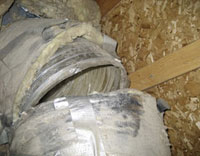
Air conditioners are measured in "tons." A 1-ton HVAC system is the equivalent of 12,000 BTU/H. Depending on the spatial layout of your home and the insulation quality of the house, you can expect every ton to cool between 300 and 800 square feet of space. Although tonnage estimates are good for initial pricing and product research, the only way to know for sure if the system is a good size is to have the home professionally evaluated by a Denver HVAC technician.
"Does an Air Conditioner's "SEER" Value Matter?
SEER stands for "Seasonal Energy Efficiency Rating." Although some air conditioners have simple EER values, seasonal values are more accurate because they measure how efficiently a cooling system will operate over an entire season according to Energy Star, a service of the EPA and U.S. Department of Energy. SEER values are important because a more efficient air conditioner will waste less energy over time, leading to decreased electricity bills. When comparing central air conditioning units, look for a SEER rating of at least 15.
Is Central Heating better than installing a heat pump?
In terms of efficiency, water transfers energy at a much higher rate than air although radiant heat has been found to be more comfortable for the human body than warm air heating from a heat pump. A weak heat pump will generally only heat one room, using fan forced air, where as a central heating system can heat the whole house with a radiator system.
Why Have Your Air Ducts Professionally Cleaned?
Contaminants in your Heating Ventilation Air Conditioning (HVAC) system can aggravate asthma and allergies. Duct Cleaning can help eliminate bacteria and fungus to improve the air quality in your home. Cleaning your air ducts can protect everyone in your home from breathing contaminated air. Cleaning your air duct system can help maintain a cleaner home, requiring less dusting. Cleaning your air duct system helps your HVAC system run more efficiently, resulting in less run time and lower heating and cooling bills. Cleaning your air duct system can also extend equipment life. You should consider having your ducts cleaned if there is substantial visible mold growth or any other physical contaminants inside sheet metal ductwork or on other components of your heating and cooling system.
What should I do if my Pilot Light goes out?
Pilot lights do go out occasionally. Some people even shut them off in the summer. Every homeowner should know how to light his or her pilot so you do not have to call a Denver HVAC technician. It isn't too difficult and there are usually instructions printed on the equipment itself. Many of today's systems don't have a pilot light, they use spark or electronic ignition. Always follow the instructions on the appliance before anything else. Turn off furnace, boiler, or water heater at thermostat or power switch. Locate the gas valve and turn knob to "pilot" position. Hold down the red button, which sends gas to the pilot burner.At the same time hold match to pilot burner. Continue holding button for 60 seconds. Now let go of button, pilot should stay lit. If not, you need to call for service. Turn gas valve knob back to the "on" position.Turn on appliance, turn up thermostat, main gas should light. Remember to put back metal cover if your system had one. If your pilot light goes out more than once a season there could be a problem.
How often should I change my air filters?
For best performance of your system your air filters should be changed every three months although this depends on the conditions in your home. If you have to dust your furniture once a week then you should stick to the quarterly filter changes. You can tell when to change an air filter by inspecting the back side of the filter, any dirt or discoloration on the back side indicates the filter is fully loaded and is releasing dirt into the air stream.
Will a programmable thermostat really save me money?
Generally, as with anything, this depends on how it is used. The more you set the thermostat to adjust the temperature above or below your standard setting, especially when you expect to be out, the more you save. Adjusting the temperature just a couple of degrees while your sleeping will save you money alone but if your home is unoccupied during the day then the savings can be substantial. You can expect a basic programmable thermostat to pay for itself within the first year under the best circumstances and easily within two to three years in circumstances where the adjustments are minimal.
How often should I change my air filters?
For best performance of your system your air filters should be changed every three months although this depends on the conditions in your home. If you have to dust your furniture once a week then you should stick to the quarterly filter changes. You can tell when to change an air filter by inspecting the back side of the filter, any dirt or discoloration on the back side indicates the filter is fully loaded and is releasing dirt into the air stream.
Will a programmable thermostat really save me money?
Generally, as with anything, this depends on how it is used. The more you set the thermostat to adjust the temperature above or below your standard setting, especially when you expect to be out, the more you save. Adjusting the temperature just a couple of degrees while your sleeping will save you money alone but if your home is unoccupied during the day then the savings can be substantial. You can expect a basic programmable thermostat to pay for itself within the first year under the best circumstances and easily within two to three years in circumstances where the adjustments are minimal.







